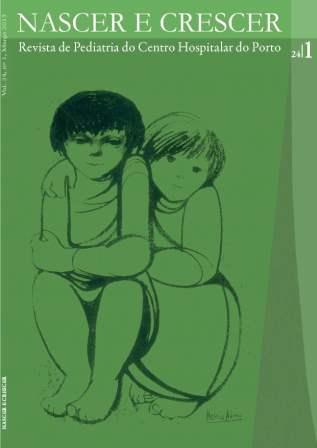Esophageal achalasia in adolescence - two case reports
DOI:
https://doi.org/10.25753/BirthGrowthMJ.v24.i1.8574Keywords:
achalasia, adolescent, eating disordersAbstract
Introduction: Achalasia is a rare disorder, particularly in pediatrics, characterized by esophageal aperistalsis and inadequate relaxation of the lower esophageal sphincter. Its etiology remains unclear.
Cases: We describe two adolescents with dysphagia for solids and liquids, vomiting, weight loss and nocturnal cough for a few months. Initially it was considered to be an eating disorder, and the diagnosis of achalasia was reached later by esophageal manometry in one case and by intraoperative biopsy in another. The patients were submitted to Heller myotomy with an antireflux procedure, laparoscopically in one case, and by laparotomy in another, both with a favorable outcome.
Discussion/Conclusions: We emphasize the rarity and diagnostic challenge of these cases. The nonspecific symptoms often lead to the diagnosis of an eating disorder, delaying the correct treatment. If symptoms persist achalasia must be considered and the esophageal manometry is the diagnostic test of choice. The gold standard in treatment is surgical, and we highlight the effectiveness of the techniques applied.
Downloads
References
Jackson CCA, Liu DC. Chapter II. 5 - Achalasia. In: Guandalini S, editor. Textbook of pediatric gastroenterology and nutrition. London: Taylor and Francis; 2004. p. 61-72.
Staiano A, Miele E, Clouse RE, Chapter 11 – Achalasia. In: Guandalini S, editor. Essential pediatric gastroenterology, hepatology, and nutrition. New York: McGraw-Hill; 2005. p.143-51.
Tannuri ACA, Tannuri U, Velhote MCP, Romão RLP. Laparoscopic extended cardiomyotomy in children: an effective procedure for the treatment of esophageal achalasia. J Pediatr Surg 2010; 45: 1463-6.
Marlais M, Fishman JR, Fell JME, Haddad MJ, Rawat DJ. UK incidence of achalasia: an 11-year national epidemiology study. Arch Dis Child 2011; 96(2): 192–4.
Sood M, Rudolph CD. Chapter 21 - Achalasia and Other Motor Disorders. In: Wyllie R, Hyams J, Kay M, editors. Pediatric Gastrointestinal and Liver Disease, 3rd ed. Philadelphia: WB Saunders; 2006. p. 329-33.
Fernandez PM, Lucio LAG, Poliachi F. Acalásia de esófago de causa desconhecida na infância. J Pediatr (Rio J). 2004;80:523-6.
Corda L, Pacilli M, Clarke S, Fell JM, Rawat D, Haddad M. Laparoscopic oesophageal cardiomyotomy without fundoplication in children with achalasia: a 10-year experience. Surg Endosc 2010; 24: 40-4.
Vaezi MF, Richter JE. Diagnosis and Management of Achalasia. Am J Gastroenterol 1999; 94 (12): 3406-11.
Lee WL, Kays DW, Chen MK, Islam S. Outcomes of treatment of childhood achalasia. J. Pediatr Surg 2010; 45: 1173-7.
Mattioli G, Esposito C, Prato AP, Doldo P, Castagnetti M, Barabino A et al. Results of laparoscopic Heller-Dor procedure for pediatric esophageal achalasia. Surg Endosc 2003; 17: 1650-2.
Downloads
Published
How to Cite
Issue
Section
License
Copyright and Authors' Rights
All articles published in Nascer e Crescer - Birth and Growth Medical Journal are Open Access and comply with the requirements of funding agencies or academic institutions. For use by third parties, Nascer e Crescer - Birth and Growth Medical Journal adheres to the terms of the Creative Commons License "Attribution - Non-Commercial Use (CC-BY-NC)".
It is the author's responsibility to obtain permission to reproduce figures, tables, etc. from other publications.
Authors must submit a Conflict of Interest statement and an Authorship Form with the submission of the article. An e-mail will be sent to the corresponding author confirming receipt of the manuscript.
Authors are permitted to make their articles available in repositories at their home institutions, provided that they always indicate where the articles were published and adhere to the terms of the Creative Commons license.


